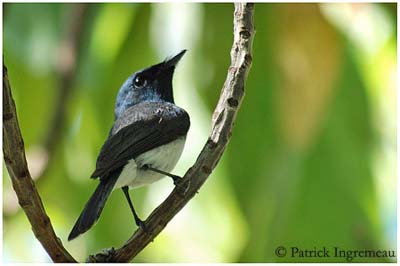
Melanesian Flycatcher
Myiagra caledonica
Passeriforme Order – Monarchidae Family
BIOMETRICS:
Length : 13-14 cm
Weight : 10-12 g
DESCRIPTION:
Melanesian Flycatcher adult male has black upperparts with greenish gloss, including wings and tail.
On the underparts, chin, throat and upper breast are black. Rest of underparts is white and undertail is pale greyish.
Head is black, with small black crest on the hind crown. Melanesian Flycatcher shows broad, flat blue-grey bill. We can see stiff rectal bristles on each side at the base of the bill. Eyes are dark brown to black. Legs and feet are dark grey to black.
Fr: Monarque mélanésien
All : Hebridenmyiagra
Esp : Miagra de Nueva Caledonia
Ital : Miagra della Nuova Caledonia
Nd : Vanuatu-monarch
Photographs by Patrick Ingremeau
His website : TAMANDUA
Text by Nicole Bouglouan
Sources:
HANDBOOK OF THE BIRDS OF THE WORLD Vol 11 by Josep del Hoyo, Andrew Elliott and David Christie - Lynx Edicions - ISBN: 849655306X
Wikipedia (Wikipedia, The Free Encyclopedia)

Female has dark grey upperparts. Wings and tail are browner.
On the underparts, chin, throat and upper breast are rufous-orange, becoming duller on flanks and belly. Lower belly and vent are whitish, as the undertail feathers.
The head is dark grey. The broad, flat bill is blackish. Eyes are dark brown, with conspicuous white eye-ring. Legs and feet are dark grey.
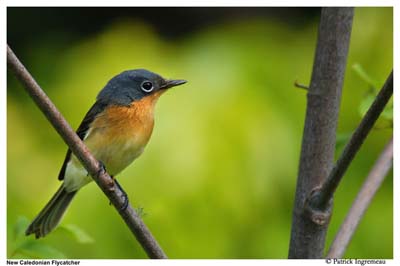
Juvenile is similar to female with duller plumage, and some buff spots on the head.
Melanesian Flycatcher has five subspecies.
M.c. occidentalis; M.c. marinae; M.c. melanura; M.c. viridinitens; M.c. caledonica.
These different traces show minor variations in plumage.
VOICE: SOUNDS BY XENO-CANTO
Melanesian Flycatcher utters loud, drawn out, moderately high-pitched whistles. The song is musical and pleasant “pseeeoo pseeeoo wit” repeated several times. This phrase may become a higher-pitched, rising “chwee chwee” and also a harsh “cherwee cherwee chersic”.
But this vocal bird also gives short “tschik” and scolding chatter which is characteristic of the Monarchidae.
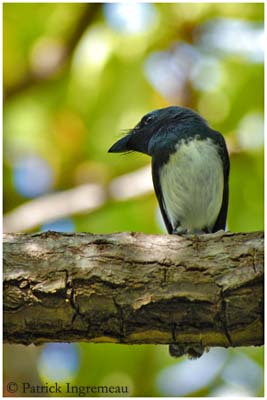
HABITAT:
Melanesian Flycatcher is sedentary in its range, and frequents open woodlands, second growth, plantations and mangroves.
This species lives from sea-level up to 1100 metres of elevation.
RANGE:
Melanesian Flycatcher is resident in New Caledonia, Salomon Islands and Vanuatu.
BEHAVIOUR:
Melanesian Flycatcher feeds mainly on insects caught in flight. The bird hunts from a perch, and performs sallies after flying insects. It also forages by flycatching at forest edges, and snatches preys from vegetation while flying, or by hovering. It is mainly an arboreal species, often seen alone, in pairs, or sometimes in small family groups.
Melanesian Flycatcher is often observed with shivering closed tail when perched.
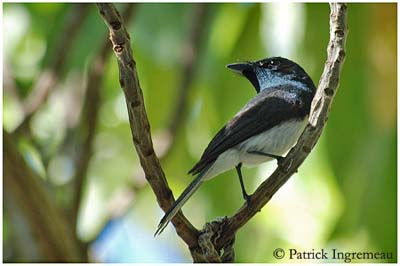
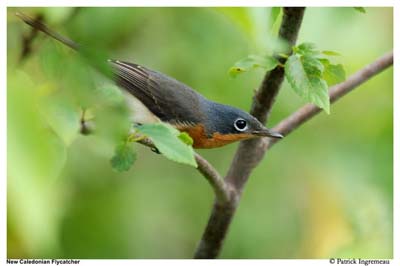
Melanesian Flycatcher is sedentary and maintains its territory all year round. It is able to mob intruders, and to become aggressive against other birds when nesting.
During breeding season, the Monarchidae use simple postures while they call loudly.
Melanesian Flycatcher pair performs courtship display, perched on a large horizontal branch. Both mates are some distance apart. Crest is raised, wings are dropped and the tail is fanned. Both sexes utter their scolding chatter while they turn in circles. The male moves towards the female, and when it is close to her, they fly together.
This behaviour is probably a pre-copulatory display. Copulation occurs without any ritual, at the end of the nest-building. (H.L. Bregulla)
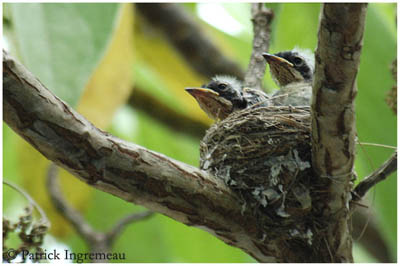
FLIGHT:
Melanesian Flycatcher has undulating flight. It is able to hover for insects, and also forages by flycatching.
REPRODUCTION:
Breeding season occurs from August to February.
The nest is built by both adults on horizontal branch or in a fork, at about 2 to 10 metres above the ground.
It is cup-shaped, neat and compact, made with plant fibres, and decorated with lichens, fine chips of bark, and sometimes with moss. The nest may be coated with spider webs.
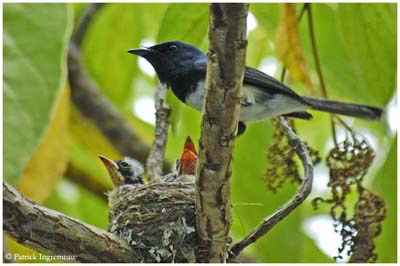
Female lays 2 to 3 pale eggs with pale brown and grey spots. Incubation lasts about 18 days, shared by both parents. The chicks are brooded and fed by both adults, and remain at nest during 17 to 19 days.
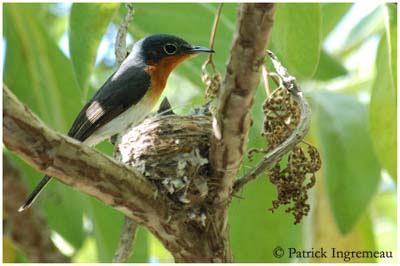
The Melanesian Flycatcher’s nest is sometimes parasitized by Fan-tailed Cuckoo (Cacomantis flabelliformis), mainly in Vanuatu.
This species usually produces one brood per season, but if the first clutch is lost, it can make a second nesting attempt.
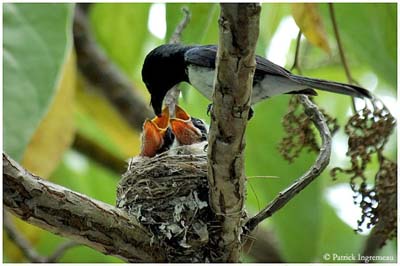
DIET:
Melanesian Flycatcher is insectivorous. It feeds mainly on insects, arthropods and larvae. It forages by flycatching, performs sallies from foliage and catches insects in flight.
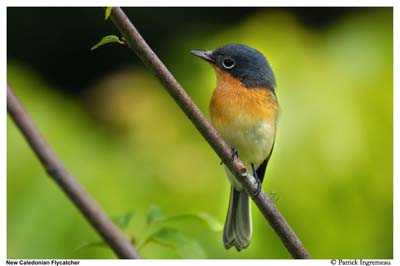
PROTECTION/ THREATS / STATUS:
Melanesian Flycatcher lives in restricted range, but it is relatively common within it. This species is not threatened at this moment.